
Church of St. Trophime
Encyclopedia
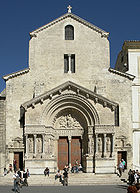
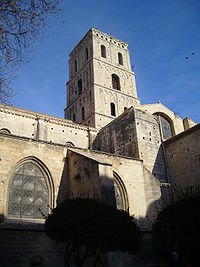
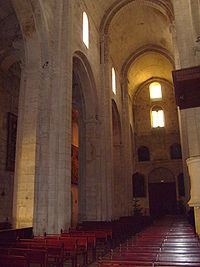
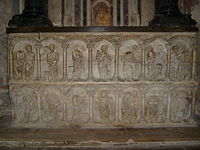
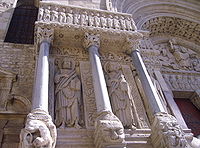
The Church of St. Trophime (Trophimus) is a Roman Catholic church and former cathedral
Cathedral
A cathedral is a Christian church that contains the seat of a bishop...
built between the 12th century and the 15th century in the city of Arles
Arles
Arles is a city and commune in the south of France, in the Bouches-du-Rhône department, of which it is a subprefecture, in the former province of Provence....
, in the Bouches-du-Rhône
Bouches-du-Rhône
Bouches-du-Rhône is a department in the south of France named after the mouth of the Rhône River. It is the most populous department of the Provence-Alpes-Côte d'Azur region. Its INSEE and postal code is 13.-History of the department:...
Department of southern France
France
The French Republic , The French Republic , The French Republic , (commonly known as France , is a unitary semi-presidential republic in Western Europe with several overseas territories and islands located on other continents and in the Indian, Pacific, and Atlantic oceans. Metropolitan France...
. The church is an important example of Romanesque architecture
Romanesque architecture
Romanesque architecture is an architectural style of Medieval Europe characterised by semi-circular arches. There is no consensus for the beginning date of the Romanesque architecture, with proposals ranging from the 6th to the 10th century. It developed in the 12th century into the Gothic style,...
, and the sculptures over the portal, particularly the Last Judgement, and the columns in the adjacent cloister, are considered some of the finest examples of Romanesque sculpture.
The church was built upon the site of the 5th century basilica
Basilica
The Latin word basilica , was originally used to describe a Roman public building, usually located in the forum of a Roman town. Public basilicas began to appear in Hellenistic cities in the 2nd century BC.The term was also applied to buildings used for religious purposes...
of Arles, named for St. Stephen. In the 15th century a Gothic choir was added to the Romanesque nave.
Timeline
- 250 According to legend, Trophimus of ArlesTrophimus of ArlesAccording to Catholic lore, Saint Trophimus of Arles was the first bishop of Arles, in today's southern France.It was an early tradition of the Church that under the co-Emperors Decius and Herennius Etruscus , Pope Fabian sent out seven bishops from Rome to Gaul, to preach the Gospel: Gatien to...
becomes the first bishop of Arles. - 597 (November 17). Augustine of CanterburyAugustine of CanterburyAugustine of Canterbury was a Benedictine monk who became the first Archbishop of Canterbury in the year 597...
returns to Arles after converting the King, Queen and principal members of the court of England to Christianity, and is consecrated as bishop of the Church of England by Virgilius of ArlesVirgilius of ArlesVirgilius of Arles was Archbishop of Arles in Gaul.According to a life written in the eighth century he was born in a village of Aquitaine, became a monk, Abbot of Lérins, and Bishop of Arles, where he built a basilica of Saint Stephen and another of the Saviour...
, vicar of the Holy SeeHoly SeeThe Holy See is the episcopal jurisdiction of the Catholic Church in Rome, in which its Bishop is commonly known as the Pope. It is the preeminent episcopal see of the Catholic Church, forming the central government of the Church. As such, diplomatically, and in other spheres the Holy See acts and...
in Gaul. - 1152 : (September 29). Raimon de Montredon organizes the transfer of the relics of St. Trophime from the basilica of St. Stephen in Alyscamps to the new cathedral of St. Trophime.
- 1178 : (July 30). The Emperor of the Holy Roman EmpireHoly Roman EmpireThe Holy Roman Empire was a realm that existed from 962 to 1806 in Central Europe.It was ruled by the Holy Roman Emperor. Its character changed during the Middle Ages and the Early Modern period, when the power of the emperor gradually weakened in favour of the princes...
, Frederick Barbarossa, is crowned at St. Trophime Cathedral by the archbishop of Arles. - 1365 : (June 4). Following the precedent of Frederick Barbarossa, Emperor Charles IVCharles IV, Holy Roman EmperorCharles IV , born Wenceslaus , was the second king of Bohemia from the House of Luxembourg, and the first king of Bohemia to also become Holy Roman Emperor....
is crowned king of ArlesKingdom of ArlesThe Kingdom of Arles or Second Kingdom of Burgundy of the High Middle Ages was a Frankish dominion established in 933 from lands of the early medieval Kingdom of Burgundy at Arles...
(Arelat) at St. Trophime Cathedral. - 1445 to 1465 The Romanesque abside of the church is replaced by a Gothic choir.
- 1801 : When the Bishopric moved to Aix-en-ProvenceAix-en-ProvenceAix , or Aix-en-Provence to distinguish it from other cities built over hot springs, is a city-commune in southern France, some north of Marseille. It is in the region of Provence-Alpes-Côte d'Azur, in the département of Bouches-du-Rhône, of which it is a subprefecture. The population of Aix is...
, St. Trophime was reclassified as a simple parish church. - 1882 : Raised to the level of a minor basilicaBasilicaThe Latin word basilica , was originally used to describe a Roman public building, usually located in the forum of a Roman town. Public basilicas began to appear in Hellenistic cities in the 2nd century BC.The term was also applied to buildings used for religious purposes...
by Pope Leo XIIIPope Leo XIIIPope Leo XIII , born Vincenzo Gioacchino Raffaele Luigi Pecci to an Italian comital family, was the 256th Pope of the Roman Catholic Church, reigning from 1878 to 1903...
. - 1981 : Classified a UNESCOUNESCOThe United Nations Educational, Scientific and Cultural Organization is a specialized agency of the United Nations...
world heritage siteWorld Heritage SiteA UNESCO World Heritage Site is a place that is listed by the UNESCO as of special cultural or physical significance...
, as part of the Arles, Roman and Romanesque MonumentsArles, Roman and Romanesque MonumentsArles, Roman and Romanesque Monuments is an area containing a collection of monuments in the city centre of Arles, France, that has been listed as a UNESCO World Heritage Site since 1981....
group.
The Church
At the time the Cathedral was built, in the late 11th century or early 12th century, Arles was the second-largest city in ProvenceProvence
Provence ; Provençal: Provença in classical norm or Prouvènço in Mistralian norm) is a region of south eastern France on the Mediterranean adjacent to Italy. It is part of the administrative région of Provence-Alpes-Côte d'Azur...
, with a population of between 15,000 and 20,000 people. It had a busy port on the Rhone River
Rhône River
The Rhone is one of the major rivers of Europe, rising in Switzerland and running from there through southeastern France. At Arles, near its mouth on the Mediterranean Sea, the river divides into two branches, known as the Great Rhone and the Little Rhone...
, and two new cities, on either side of the old Roman town, surrounded by a wall. It was at least formally independent as the Kingdom of Arles
Kingdom of Arles
The Kingdom of Arles or Second Kingdom of Burgundy of the High Middle Ages was a Frankish dominion established in 933 from lands of the early medieval Kingdom of Burgundy at Arles...
, and it had attracted many religious orders, including the Knights Hospitalier, the Knights Templar
Knights Templar
The Poor Fellow-Soldiers of Christ and of the Temple of Solomon , commonly known as the Knights Templar, the Order of the Temple or simply as Templars, were among the most famous of the Western Christian military orders...
and mendicant
Mendicant
The term mendicant refers to begging or relying on charitable donations, and is most widely used for religious followers or ascetics who rely exclusively on charity to survive....
orders, which had built a number of churches within the town.
The apse
Apse
In architecture, the apse is a semicircular recess covered with a hemispherical vault or semi-dome...
and the transept
Transept
For the periodical go to The Transept.A transept is a transverse section, of any building, which lies across the main body of the building. In Christian churches, a transept is an area set crosswise to the nave in a cruciform building in Romanesque and Gothic Christian church architecture...
were probably built first, in the late 11th century, and the nave
Nave
In Romanesque and Gothic Christian abbey, cathedral basilica and church architecture, the nave is the central approach to the high altar, the main body of the church. "Nave" was probably suggested by the keel shape of its vaulting...
and bell tower were completed in the second quarter of the 12th century. : The Romaneque church had a long central nave 20 meters high; lower collateral aisles on either side; a transept supporting the square central bell tower; and a chevet behind the altar at the east end with a hemispherical vault. The windows are small and high up on the nave, above the level of the collateral aisles.
The West Portal

Apocalypse
An Apocalypse is a disclosure of something hidden from the majority of mankind in an era dominated by falsehood and misconception, i.e. the veil to be lifted. The Apocalypse of John is the Book of Revelation, the last book of the New Testament...
according to St. John
John of Patmos
John of Patmos is the name given, in the Book of Revelation, as the author of the apocalyptic text that is traditionally cannonized in the New Testament...
, and the Gospel
Gospel
A gospel is an account, often written, that describes the life of Jesus of Nazareth. In a more general sense the term "gospel" may refer to the good news message of the New Testament. It is primarily used in reference to the four canonical gospels of Matthew, Mark, Luke, and John...
of St. Matthew. Christ is seated in majesty in the timpanum, with the symbols of the Evangelists
Evangelism
Evangelism refers to the practice of relaying information about a particular set of beliefs to others who do not hold those beliefs. The term is often used in reference to Christianity....
around him; the angel of St. Matthew, the lion of St. Mark, the bull of St. Luke, and the eagle of St. John. The Apostles are seated below him. To the left of the portal, a procession of chosen Christians are going to heaven, while to the right sinners are being cast into hell.
The decoration of the portal also includes a multitude of Biblical scenes; the Annunciation
Annunciation
The Annunciation, also referred to as the Annunciation to the Blessed Virgin Mary or Annunciation of the Lord, is the Christian celebration of the announcement by the angel Gabriel to Virgin Mary, that she would conceive and become the mother of Jesus the Son of God. Gabriel told Mary to name her...
; the Baptism of Christ; the Adoration of the Magi, the Magi before Herod
Herod the Great
Herod , also known as Herod the Great , was a Roman client king of Judea. His epithet of "the Great" is widely disputed as he is described as "a madman who murdered his own family and a great many rabbis." He is also known for his colossal building projects in Jerusalem and elsewhere, including his...
; the Massacre of the Innocents
Massacre of the Innocents
The Massacre of the Innocents is an episode of infanticide by the King of Judea, Herod the Great. According to the Gospel of Matthew Herod orders the execution of all young male children in the village of Bethlehem, so as to avoid the loss of his throne to a newborn King of the Jews whose birth...
; shepherds with their flocks.
On the lower level, separated by pillasters and columns of dark stone, are statues of saints connected with the history of Arles; on the left, St. Bartholomew, St. James the Great, St. Trophimus, St. John the Evangelist, and St. Peter; and on the right, St. Philip, St. James the Just, St. Stephen, St. Andrew, and St. Paul.
The bases of the columns beside the portal are decorated with statues of lions, Samson
Samson
Samson, Shimshon ; Shamshoun or Sampson is the third to last of the Judges of the ancient Israelites mentioned in the Tanakh ....
and Delilah
Delilah
Delilah appears only in the Hebrew bible Book of Judges 16, where she is the "woman in the valley of Sorek" whom Samson loved, and who was his downfall...
, and Samson and the Lion.
The Cloister

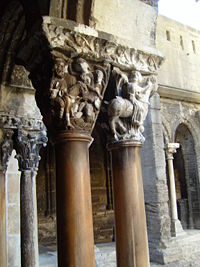



Canon (priest)
A canon is a priest or minister who is a member of certain bodies of the Christian clergy subject to an ecclesiastical rule ....
, the priests who attended the bishop and managed the church property. Under a reform instituted by Pope Gregory
Pope Gregory
Pope Gregory has been the name of sixteen Roman Catholic Popes and two Antipopes:#Pope Gregory I, also called Gregory the Great#Pope Gregory II#Pope Gregory III#Pope Gregory IV#Pope Gregory V#Pope Gregory VI#*Antipope Gregory VI...
, the Canons were required to live like monks, with a common dormitory, refectory and cloister within the cathedral enclosure, separated by a wall from the city.
The refectory, or dining hall, was built first, next to the church, along with a chapter house, or meeting room, for the canons. The dormitory for the canons, a large vaulted room on the east side of the cloister, was built next. Work on the cloister began with the northern gallery, then the eastern gallery, which were finished around 1210-1220. Then work suddenly stopped.
Soon after the construction of the east and west galleries, the city began to decline. The Counts of Provence moved from Arles to Aix
Aix-en-Provence
Aix , or Aix-en-Provence to distinguish it from other cities built over hot springs, is a city-commune in southern France, some north of Marseille. It is in the region of Provence-Alpes-Côte d'Azur, in the département of Bouches-du-Rhône, of which it is a subprefecture. The population of Aix is...
, the center of church authority moved to the papal palace in Avignon
Avignon
Avignon is a French commune in southeastern France in the départment of the Vaucluse bordered by the left bank of the Rhône river. Of the 94,787 inhabitants of the city on 1 January 2010, 12 000 live in the ancient town centre surrounded by its medieval ramparts.Often referred to as the...
, and in 1251 Charles of Anjou suppressed the movement of the leaders of Arles for more independence. In 1348, The Black Death
Black Death
The Black Death was one of the most devastating pandemics in human history, peaking in Europe between 1348 and 1350. Of several competing theories, the dominant explanation for the Black Death is the plague theory, which attributes the outbreak to the bacterium Yersinia pestis. Thought to have...
drastically reduced the population of all of Provence.
The southern and western galleries of the cloister were not built until the 1380s and 1390s, and they were built in a different style, the Gothic
Gothic architecture
Gothic architecture is a style of architecture that flourished during the high and late medieval period. It evolved from Romanesque architecture and was succeeded by Renaissance architecture....
style favored by the Popes in Avignon
Avignon
Avignon is a French commune in southeastern France in the départment of the Vaucluse bordered by the left bank of the Rhône river. Of the 94,787 inhabitants of the city on 1 January 2010, 12 000 live in the ancient town centre surrounded by its medieval ramparts.Often referred to as the...
, with cross-ribbed vaults.
In 1355, the canons gave up living in the dormitory, and moved to houses within the cathedral close. The dormitory, refectory and chapter house were turned into granaries and storehouses.
The northern gallery, built in the second quarter of the 12th century, is purely Romanesque, with a barrel vault ceiling. The carvings of the columns capitals are devoted to the Easter Mystery and to the glorification of the patron saints of Arles. The relationships between the figures on the pillars and the capitals of the columns show the relationships between the Old and New Testaments, a theme introduced in Paris by Suger, the abbot of Saint Denis.
The first corner pillar in the northern gallery is devoted to St. Trophime, the patron saint Arles, between the figures of Saint Peter
Saint Peter
Saint Peter or Simon Peter was an early Christian leader, who is featured prominently in the New Testament Gospels and the Acts of the Apostles. The son of John or of Jonah and from the village of Bethsaida in the province of Galilee, his brother Andrew was also an apostle...
and Saint John
John the Apostle
John the Apostle, John the Apostle, John the Apostle, (Aramaic Yoħanna, (c. 6 - c. 100) was one of the Twelve Apostles of Jesus. He was the son of Zebedee and Salome, and brother of James, another of the Twelve Apostles...
. The bas-relief on the walls show the Christ's empty tomb on Easter morning. The capitals of the columns depict Lazarus
Lazarus of Bethany
Lazarus of Bethany, also known as Saint Lazarus or Lazarus of the Four Days, is the subject of a prominent miracle attributed to Jesus in the Gospel of John, in which Jesus restores him to life four days after his death...
coming out of his tomb between Martha
Martha
Martha of Bethany is a biblical figure described in the Gospels of Luke and John. Together with her siblings Lazarus and Mary, she is described as living in the village of Bethany near Jerusalem...
and Mary; Abraham
Abraham
Abraham , whose birth name was Abram, is the eponym of the Abrahamic religions, among which are Judaism, Christianity and Islam...
about to sacrifice his son; and Balaam
Balaam
Balaam is a diviner in the Torah, his story occurring towards the end of the Book of Numbers. The etymology of his name is uncertain, and discussed below. Every ancient reference to Balaam considers him a non-Israelite, a prophet, and the son of Beor, though Beor is not so clearly identified...
on his ass being stopped by a sword-wielding angel.
The next three columns show St. Stephen being stoned, combined with a portrait of St. Paul; Christ encountering the disciples,shown as pilgrims on their way to Compostela
Santiago de Compostela
Santiago de Compostela is the capital of the autonomous community of Galicia, Spain.The city's Cathedral is the destination today, as it has been throughout history, of the important 9th century medieval pilgrimage route, the Way of St. James...
, at Emaus; and Christ showing his wounds to the unbelieving Thomas
Thomas the Apostle
Thomas the Apostle, also called Doubting Thomas or Didymus was one of the Twelve Apostles of Jesus. He is best known for questioning Jesus' resurrection when first told of it, then proclaiming "My Lord and my God" on seeing Jesus in . He was perhaps the only Apostle who went outside the Roman...
.
The capitals between the columns show three Angels appearing to Abraham
Abraham
Abraham , whose birth name was Abram, is the eponym of the Abrahamic religions, among which are Judaism, Christianity and Islam...
; and St. Paul addressing Areopagus
Areopagus
The Areopagus or Areios Pagos is the "Rock of Ares", north-west of the Acropolis, which in classical times functioned as the high Court of Appeal for criminal and civil cases in Athens. Ares was supposed to have been tried here by the gods for the murder of Poseidon's son Alirrothios .The origin...
of Athens.
The only illustrated capital in the last bay shows Moses
Moses
Moses was, according to the Hebrew Bible and Qur'an, a religious leader, lawgiver and prophet, to whom the authorship of the Torah is traditionally attributed...
meeting God before the burning bush. The Resurrection story concludes on the northeast corner pillar with the Ascension of Jesus, next to the figures of Saint Paul and St. Andrew on either side of St. Stephen.
The Eastern Gallery, built the late 12th or early 13th century, has some Gothic features, including figures in the quoins of wise virgins and foolish virgins and the symbols of the Four Evangelists
Four Evangelists
In Christian tradition the Four Evangelists are Matthew, Mark, Luke, and John, the authors attributed with the creation of the four Gospel accounts in the New Testament that bear the following titles:*Gospel according to Matthew*Gospel according to Mark...
. The Passion
Passion (Christianity)
The Passion is the Christian theological term used for the events and suffering – physical, spiritual, and mental – of Jesus in the hours before and including his trial and execution by crucifixion...
story is told on the pillars, while the life of Christ is depicted on the carved capitals.
The scenes of Christ's childhood can be are read on the capitals from north to south; the Annunciation
Annunciation
The Annunciation, also referred to as the Annunciation to the Blessed Virgin Mary or Annunciation of the Lord, is the Christian celebration of the announcement by the angel Gabriel to Virgin Mary, that she would conceive and become the mother of Jesus the Son of God. Gabriel told Mary to name her...
, the Visitation and the Nativity
Nativity of Jesus in art
The Nativity of Jesus has been a major subject of Christian art since the 4th century. The artistic depictions of the Nativity or birth of Jesus, celebrated at Christmas, are based on the narratives in the Bible, in the Gospels of Matthew and Luke, and further elaborated by written, oral and...
on the first capital; the next capital shows the coat of arms of Arles and an eagle with spread wings, the symbol of the Holy Roman Emperor
Holy Roman Emperor
The Holy Roman Emperor is a term used by historians to denote a medieval ruler who, as German King, had also received the title of "Emperor of the Romans" from the Pope...
, who at the time ruled Arles; the third capital shows the Annunciation to the shepherds
Annunciation to the shepherds
The Annunciation to the shepherds is an episode in the Nativity of Jesus described in the Bible in Luke 2, in which angels tell a group of shepherds about the birth of Jesus...
, with two startled goats climbing the Tree of Life
Tree of Life
The tree of life in the Book of Genesis is a tree planted by God in midst of the Garden of Eden , whose fruit gives everlasting life, i.e. immortality. Together with the tree of life, God planted the tree of the knowledge of good and evil . According to some scholars, however, these are in fact...
.
The pillar in the first bay begins the story of the Passion with the flagellation of Christ. On the opposite side is Judas
Judas Iscariot
Judas Iscariot was, according to the New Testament, one of the twelve disciples of Jesus. He is best known for his betrayal of Jesus to the hands of the chief priests for 30 pieces of silver.-Etymology:...
clutching a purse with thirty pieces of silver.
The capitals in the central bay illustrate the story of the Magi
Magi
Magi is a term, used since at least the 4th century BC, to denote a follower of Zoroaster, or rather, a follower of what the Hellenistic world associated Zoroaster with, which...
, out of historical order; the successive columns show the Massacre of the Innocents
Massacre of the Innocents
The Massacre of the Innocents is an episode of infanticide by the King of Judea, Herod the Great. According to the Gospel of Matthew Herod orders the execution of all young male children in the village of Bethlehem, so as to avoid the loss of his throne to a newborn King of the Jews whose birth...
; the Flight into Egypt
Flight into Egypt
The flight into Egypt is a biblical event described in the Gospel of Matthew , in which Joseph fled to Egypt with his wife Mary and infant son Jesus after a visit by Magi because they learn that King Herod intends to kill the infants of that area...
; the angel appearing to the Magi at the inn; the three wise men before Herod; the Adoration of the Magi, and the angel appearing to Joseph
Saint Joseph
Saint Joseph is a figure in the Gospels, the husband of the Virgin Mary and the earthly father of Jesus Christ ....
in a dream.
The pillar in the second bay has two statues, probably representing St. John and the Mother Church.
The capitals in the third bay illustrate the entry of Christ into Jerusalem, Palm Sunday
Palm Sunday
Palm Sunday is a Christian moveable feast that falls on the Sunday before Easter. The feast commemorates Jesus' triumphal entry into Jerusalem, an event mentioned in all four Canonical Gospels. ....
and Pentacost, and a knight striking down an adversary, and then walking over to a lady; possibly representing Constantine defeating paganism and then being thanked by the mother church.
The southern pillar illustrates the Baptism of Christ and the devil tempting Christ, Christ washing the apostles' feet, the Last Supper
Last Supper
The Last Supper is the final meal that, according to Christian belief, Jesus shared with his Twelve Apostles in Jerusalem before his crucifixion. The Last Supper provides the scriptural basis for the Eucharist, also known as "communion" or "the Lord's Supper".The First Epistle to the Corinthians is...
and the kiss of Judas.
The Southern Gallery probably dates to the 1380s or 1390s, and is built in the Gothic style, with pointed arches interesecting vaults resting on colonnettes with foliated capitals.
The capitals in the southern gallery are entirely devoted to the story of St. Trophimus; the first shows St. Trophime blessing the Alyscamps burial ground, and dedicating an oratory to the still-living Virgin Mary; the next four show a miracle performed by the intervention of St. Trophime; he brings back to life a knight and nine of his relatives unjustly sentenced to death by the Emperor Charlemagne
Charlemagne
Charlemagne was King of the Franks from 768 and Emperor of the Romans from 800 to his death in 814. He expanded the Frankish kingdom into an empire that incorporated much of Western and Central Europe. During his reign, he conquered Italy and was crowned by Pope Leo III on 25 December 800...
for slapping the archbishop Turpin.
The Western Gallery probably dates to about 1375, and is devoted to religious figures and scenes popular in Provence; from south to north: the stoning of St. Stephen; Samson
Samson
Samson, Shimshon ; Shamshoun or Sampson is the third to last of the Judges of the ancient Israelites mentioned in the Tanakh ....
slaying the lion and yielding to Delilah
Delilah
Delilah appears only in the Hebrew bible Book of Judges 16, where she is the "woman in the valley of Sorek" whom Samson loved, and who was his downfall...
; Saint Martha
Martha
Martha of Bethany is a biblical figure described in the Gospels of Luke and John. Together with her siblings Lazarus and Mary, she is described as living in the village of Bethany near Jerusalem...
and the Tarasque
Tarasque
The Tarasque is a fearsome legendary dragon from Provence, in southern France, tamed in a story about Saint Martha. On 25 November 2005 the UNESCO included the Tarasque on the list of Masterpieces of the Oral and Intangible Heritage of Humanity....
; Mary Magdalene
Mary Magdalene
Mary Magdalene was one of Jesus' most celebrated disciples, and the most important woman disciple in the movement of Jesus. Jesus cleansed her of "seven demons", conventionally interpreted as referring to complex illnesses...
kissing Christ's feet; the Annunciation
Annunciation
The Annunciation, also referred to as the Annunciation to the Blessed Virgin Mary or Annunciation of the Lord, is the Christian celebration of the announcement by the angel Gabriel to Virgin Mary, that she would conceive and become the mother of Jesus the Son of God. Gabriel told Mary to name her...
in a Gothic setting; the Coronation of the Virgin; and the Pentacost.
See also
- Our Lady of Victory ChapelDerham Hall and Our Lady of Victory Chapel, College of Saint CatherineDerham Hall and Our Lady of Victory Chapel are educational and religious buildings part of the St. Catherine University in Saint Paul, Minnesota....
a MinnesotaMinnesotaMinnesota is a U.S. state located in the Midwestern United States. The twelfth largest state of the U.S., it is the twenty-first most populous, with 5.3 million residents. Minnesota was carved out of the eastern half of the Minnesota Territory and admitted to the Union as the thirty-second state...
church whose architecture was strongly influenced by St. Trophime. - Trophimus of ArlesTrophimus of ArlesAccording to Catholic lore, Saint Trophimus of Arles was the first bishop of Arles, in today's southern France.It was an early tradition of the Church that under the co-Emperors Decius and Herennius Etruscus , Pope Fabian sent out seven bishops from Rome to Gaul, to preach the Gospel: Gatien to...
External links
- Saint-Trophime Digital Media Archive (creative commons-licensed photos, laser scans, panoramas) on the portal, interior of church, and cloister (particularly the column capitals), using data from a World Monuments FundWorld Monuments FundWorld Monuments Fund is a private, international, non-profit organization dedicated to the preservation of historic architecture and cultural heritage sites around the world through fieldwork, advocacy, grantmaking, education, and training....
/CyArkCyArkCyArk is a 501 nonprofit organization located in Oakland, California, United States. The company's website refers to it as a "digital archive of the world’s heritage sites for preservation and education"...
research partnership

